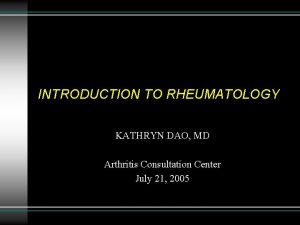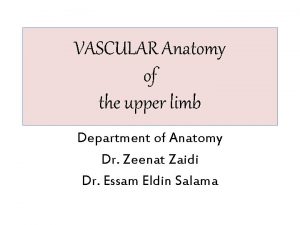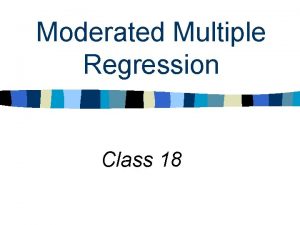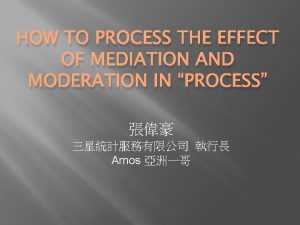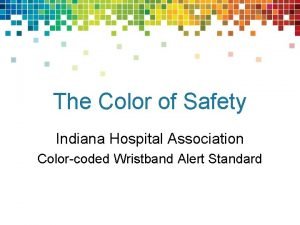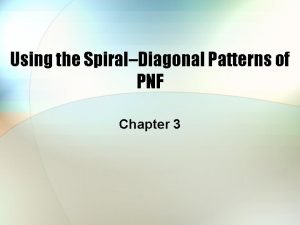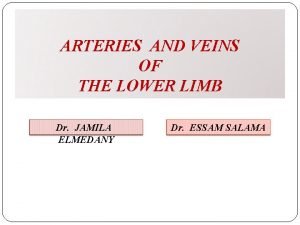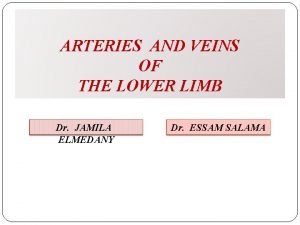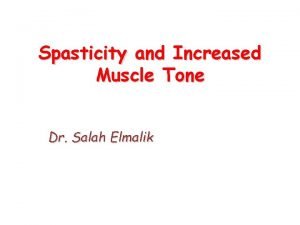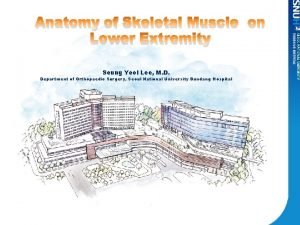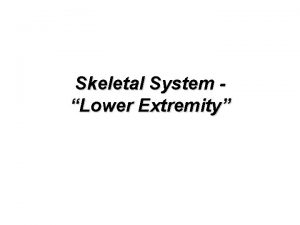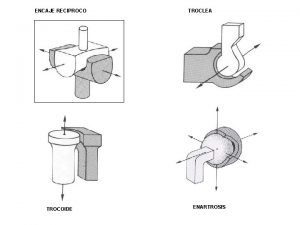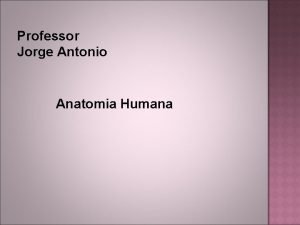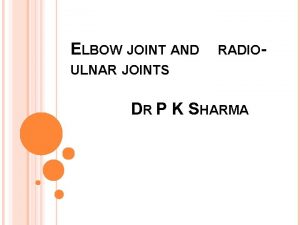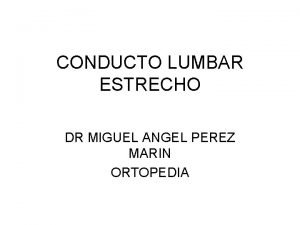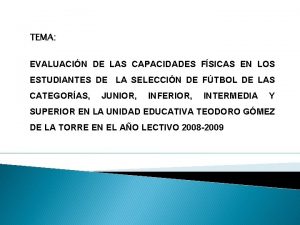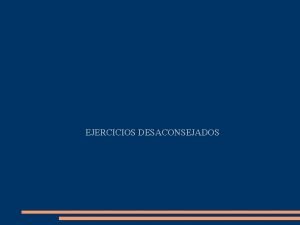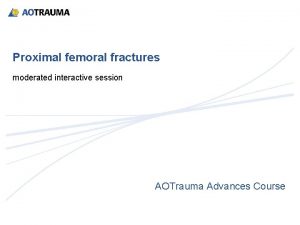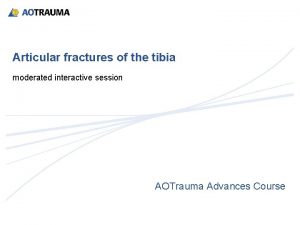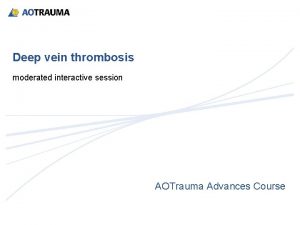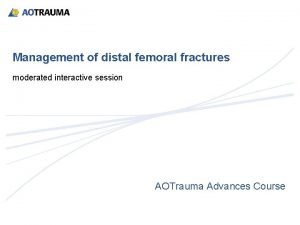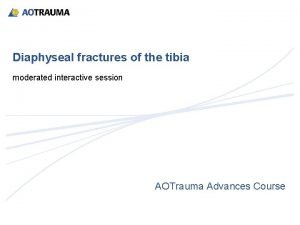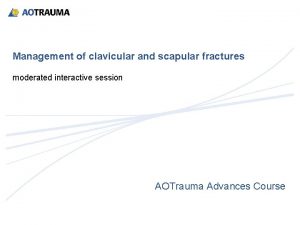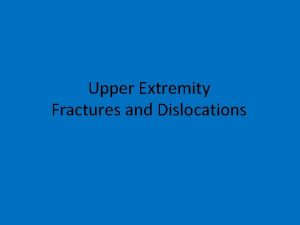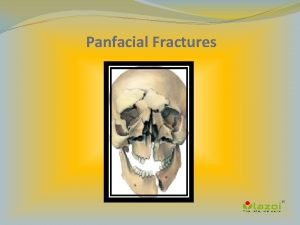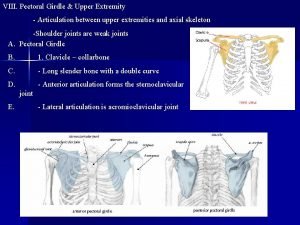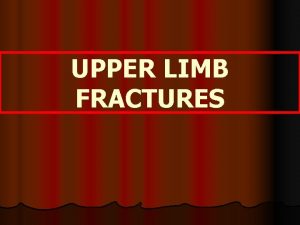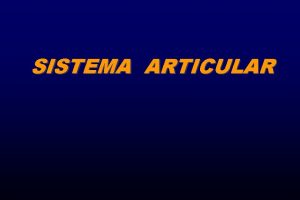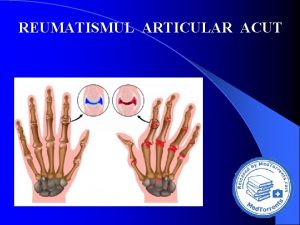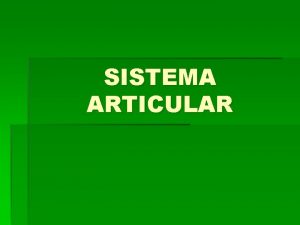Articular fractures upper extremity moderated interactive session AOTrauma



































- Slides: 35

Articular fractures upper extremity moderated interactive session AOTrauma Advances Course

Learning outcomes • Manage complex elbow dislocations • Evaluate evidence for fixation vs replacement in proximal humeral fractures • List the indications and surgical techniques for distal humeral fractures • Discuss an algorithm for the use of ORIF vs external fixation vs pins in the treatment of distal radial fractures

Is fixation with locked plating the treatment of choice for distal radial fractures in your practice? 1. Never 2. Rarely 3. Occasionally 4. Commonly

Key points from lectures Proximal humerus • ORIF as a first treatment option in all reducible fractures • New MIPO approaches • Hemiarthroplasty for old patients/irreducible fractures/painful avascular necrosis Distal humerus • Requires ORIF using both column fixation? • Posterior approach utilizing an olecranon osteotomy is still recommended. • Predictable outcomes

Key points from lectures Elbow fracture dislocation • Injury pattern tells you what structures are likely to be injured and how • The LCL is more important than the MCL • Keep elbow concentric • Coronoid fractures can be a problem Distal radius fractures, C 3 types • Stable fixation is the key to good outcomes • Patient function improves up to 1 year postoperatively • DASH scores improve over 2 years, but uncommonly returned to baseline

58 -year-old man, motorcycle collision • Isolated injury to right upper extremity • Grade 1 open injury • NV status good

What is the treatment after debridement? 1. Fixation with locking plate 2. Tension band construct 3. Intramedullary nailing 4. Hemiarthroplasty 5. Nonoperative care


58 -year-old female, pedestrian hit by car • Housewife • Nondominant extremity • Closed isolated injury • Neurovascular status ok

What would your initial step be? 1. X-ray of axial view 2. CT 3. Reduction in ER 4. Reduction in OR

After closed reduction in ER

What treatment options would you offer? 1. ORIF with standard plates 2. ORIF with locked plates 3. Screw fixation 4. Hemiarthroplasty 5. Other

postoperative x-rays

25 -year-old female, fall on the street • Dominant extremity • Closed isolated injury • Neurovascular status ok

What would your surgical approach be? 1. Posterior with olecranon osteotomy 2. Posterior—triceps reflection 3. 2 incisions—medial/lateral 4. Other


What would your choice of implant be? 1. Two conventional plates—parallel 2. One conventional plate—specialty type 3. Two conventional plates—orthogonal 4. Two locking plates—precontoured


Do you prescribe prophylaxis treatment to prevent heterotopic ossification? 1. Always 2. Sometimes or depends 3. Never

Do you transpose the ulnar nerve? 1. Always 2. Sometimes or depends 3. Never


49 -year-old male banker, falls off bike • Fracture dislocation of elbow • Wrist is normal and NV status is ok • Reduction of dislocation reveals elbow pathology

How would you proceed with treatment? 1. Radial head replacement 2. Radial head ORIF 3. Radial head ORIF with coronoid ORIF 4. Radial head ORIF with coronoid ORIF and medial ligament reconstruction 5. Cannot tell and need a CT

Which coronoid fractures should be managed with ORIF? 1. All 2. Large displaced coronoid fractures only 3. Fractures that present with a dislocation 4. Most fractures should be treated if the other stabilizers of the elbow are injured as well


43 -year-old female, fell on the street • Bilateral distal radial fracture • Closed injuries • Neurovascular status ok

left right

Reduction and plaster cast left right

What now? 1. Continuation of conservative treatment 2. Further diagnostic procedures (CT) 3. Immediate surgical treatment 4. Spanning external fixator

Left

Right

What treatment would you offer now? 1. Percutaneous K-wire fixation 2. External fixator for right side and conservative treatment of left side 3. Conventional plates dorsal for left side and palmar for right side 4. Locking dorsal plate for right side and double locking plate for left side 5. Other

6 weeks postoperatively left right

3 months postoperatively

Summary • Anatomical reduction and early ROM is vital for restoration of function • New locking plates can be useful • Attempt ORIF for most displaced fractures of the proximal humerus in healthy patients • Distal humeral fractures require ORIF with both column fixation • Stability is the key to success in managing complex injuries around the elbow—bone and soft tissues • Stable fixation for all of the radial columns injuries will lead to good outcomes
 Articular vs non articular
Articular vs non articular Aotrauma reference
Aotrauma reference Axillary artery
Axillary artery The biomechanics of the human upper extremity
The biomechanics of the human upper extremity Upper extremity pnf patterns
Upper extremity pnf patterns Grant's atlas
Grant's atlas Closed kinematic chain
Closed kinematic chain East bay hand & upper extremity
East bay hand & upper extremity Moderated multiple regression
Moderated multiple regression Moderated multiple regression
Moderated multiple regression Moderated serial mediation
Moderated serial mediation Mediation vs moderation psychology
Mediation vs moderation psychology Poster imrad
Poster imrad Restricted extremity wristband
Restricted extremity wristband Pnf diagonal patterns lower extremity
Pnf diagonal patterns lower extremity Dorsalis pedis artery
Dorsalis pedis artery Emergency move vs rapid extrication
Emergency move vs rapid extrication Abdominal restraint procedure
Abdominal restraint procedure Left lower extremity
Left lower extremity Femoral pulse
Femoral pulse Tone vs spasticity
Tone vs spasticity Muscles of thigh cross section
Muscles of thigh cross section Lesser trochanter muscle
Lesser trochanter muscle Lower extremity appendicular skeleton
Lower extremity appendicular skeleton Lower extremity pulses
Lower extremity pulses Ligamentos de la muñeca
Ligamentos de la muñeca Olecrano ulna
Olecrano ulna Elbow bone
Elbow bone Agujero de conjuncion
Agujero de conjuncion Displaced intra articular fracture
Displaced intra articular fracture Perpendicular plate of palatine bone
Perpendicular plate of palatine bone Sacral base and apex
Sacral base and apex Test de movilidad articular
Test de movilidad articular Accion articular desaconsejada
Accion articular desaconsejada Rheumatoid arthritis extra-articular manifestations
Rheumatoid arthritis extra-articular manifestations Ala of sacrum
Ala of sacrum
